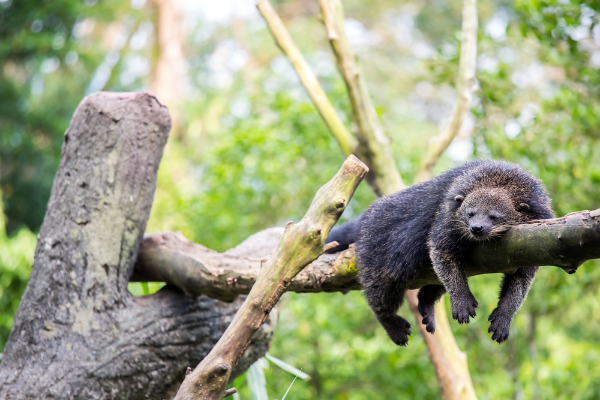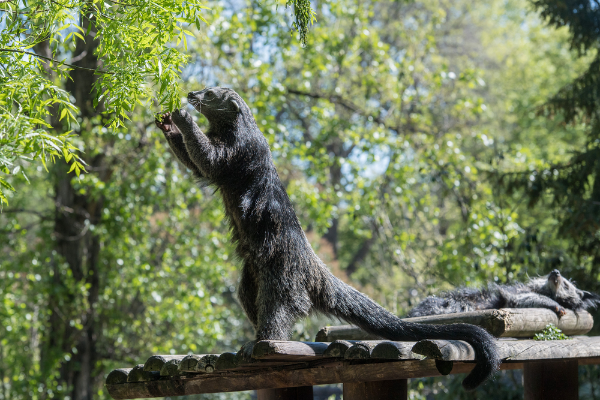Binturongs, also known as bearcats, are a unique and rarely seen member of the cat family. They are found in Southeast Asia and parts of South Asia, and they typically live in dense forests. Binturongs are carnivores, and they eat mostly small animals, but they will also eat fruits and vegetables. Despite their shy nature, binturongs make interesting pets for those who are able to provide them with a safe home.

Binturong Description
The Binturong, also known as the Bearcat, is a species of cat found in parts of Southeast Asia. Binturongs are arboreal animals, meaning they live in trees, and are proficient climbers. They have long tails that they use for balancing while climbing, and their claws are sharp and curved, making them well-suited for life in the trees. Binturongs are typically dark brown or black in color, with a shaggy coat of fur. They have a bear-like appearance, which has led to their nickname of Bearcat. Binturongs are nocturnal animals, meaning they are most active at night. They are solitary creatures, only coming together to mate. Binturongs typically live for around 20 years in the wild.
Binturong Habitat
Binturongs are found in the tropical forests of Southeast Asia, ranging from southern India to Indonesia. They prefer areas with dense vegetation and lots of trees, where they can climb and move about easily. Binturongs are also known as “bearcats”, although they are not related to either bears or cats. They are instead members of the family Viverridae, which includes civets and mongooses. Binturongs are typically nocturnal animals, spending the majority of their time in the trees. During the day, they often rest in hollows or on branches high up off the ground. Binturongs are good climbers and can even hang upside down from branches using their prehensile tails. Their diet consists mainly of fruits and insects, which they find by scent. Binturongs play an important role in dispersing seeds through their feces, which helps to keep the forest ecosystem healthy and diverse.
Binturong Diet
Binturongs are arboreal creatures, meaning that they spend the majority of their time in trees. As a result, their diet consists primarily of fruits, leaves, and insects. Binturongs are known to eat over 200 different types of fruits, and they have been known to travel long distances in order to find a particular type of food. In addition to fruits and leaves, binturongs also eat invertebrates such as worms, spiders, and scorpions. Binturongs have even been known to eat small mammals such as rodents and bats. While the binturong’s diet is varied, it is important to note that they primarily eat plants. Fruits and leaves make up the bulk of their diet, with insects and other invertebrates making up a smaller portion.
Binturong Size
Binturongs are members of the bearcat family and are native to parts of Southeast Asia. They are relatively large animals, with some individuals reaching up to 3 feet in length and weighing over 50 pounds. Binturongs are also unique in their appearance, sporting shaggy black fur and a long prehensile tail. Despite their size and impressive appearance, binturongs are actually quite shy and reclusive animals. They spend most of their time high in the trees, only descending to the ground to forage for food. Binturongs are also nocturnal creatures, meaning they are most active at night. Due to their secretive nature, little is known about the day-to-day lives of these elusive animals.
Binturong Lifespan
Binturongs are a species of arboreal mammal native to Southeast Asia. They are also known as “bearcats”, although they are not closely related to either bears or cats. Binturongs typically have a lifespan of 20-30 years in the wild, and up to 35 years in captivity. Binturongs are an endangered species due to habitat loss and hunting pressure. However, their population is believed to be stable, and they are not currently considered threatened with extinction.

Binturong Behavior
Binturongs are unusual creatures, and their behavior is just as curious as their appearance. Binturongs are solitary animals, and they are mostly active at night. During the day, they sleep in trees, coiled up like a cat. Binturongs are also known for their love of bathing, and they often spend hours soaking in streams or pools. Binturongs are gentle beings, and they are not known to be aggressive. In fact, they are often described as being “docile.” Binturongs have a keen sense of smell, and they use this sense to help them find food. Binturongs are omnivores, and they enjoy eating fruits, leaves, insects, and small animals. Binturongs are interesting creatures, and their unusual behavior is part of what makes them so special.
Binturong Speed
The Binturong, also known as the “Bearcat”, is a furry creature that looks like a cross between a cat and a monkey. native to Southeast Asia, this arboreal animal is proficient in climbing trees and is known for its shaggy black fur and long tail. Binturongs are interesting creatures; they are the only mammal that can urinate backwards and they have a prehensile tail that they use to grip branches. Binturongs are also proficient swimmers and can reach speeds of up to 30 miles per hour in short bursts. This makes them one of the fastest mammals in the world, second only to the cheetah. Binturongs are an endangered species due to habitat loss and hunting, but thankfully they are now protected by law in many countries. Hopefully, with more awareness of this incredible animal, the Binturong will make a comeback.
Binturong Hunting
Binturong hunting is a common practice in many parts of the world. Binturongs are typically hunted for their fur, which is used to make clothes and other items. In some areas, binturong hunting is also done for sport. Binturongs are difficult to find and capture, so hunters often have to use dogs or other animals to track them down. Binturong hunting can be dangerous, as the animals are large and strong. They can also be aggressive, so hunters must be careful when approaching them. Binturong hunting is regulated in some countries, and only certain types of methods are allowed. In general, though, binturong hunting is a popular activity that helps provide people with valuable resources.
Conclusion
The binturong is an interesting creature that has many unique features. We hope you have enjoyed learning about this animal.
Frequently Asked Question

